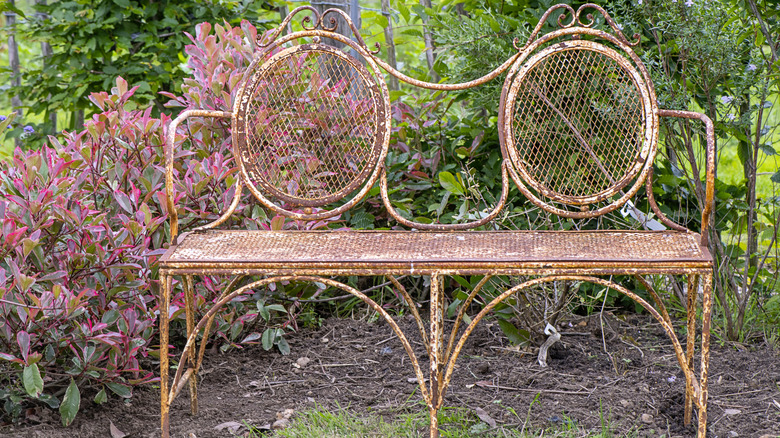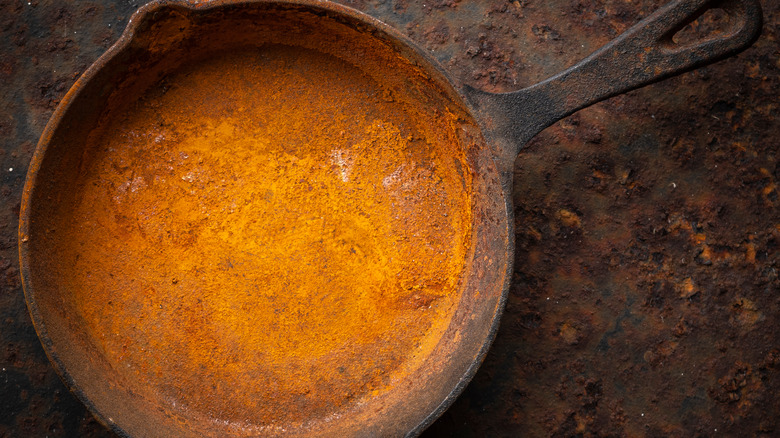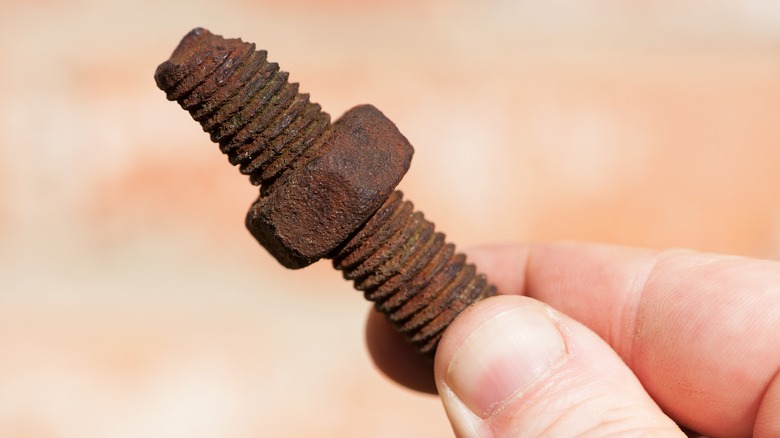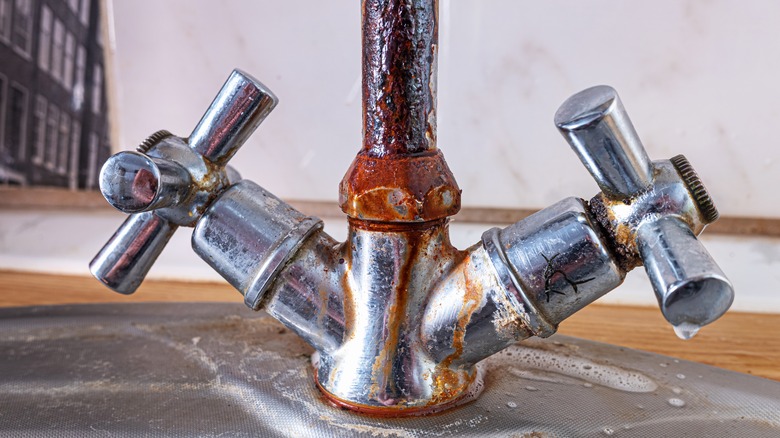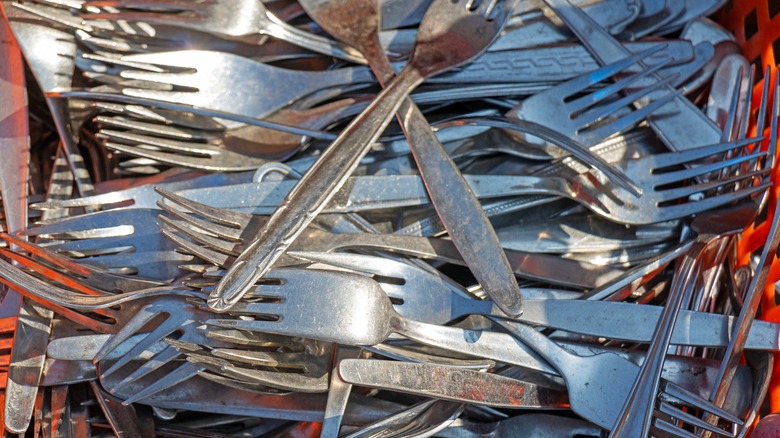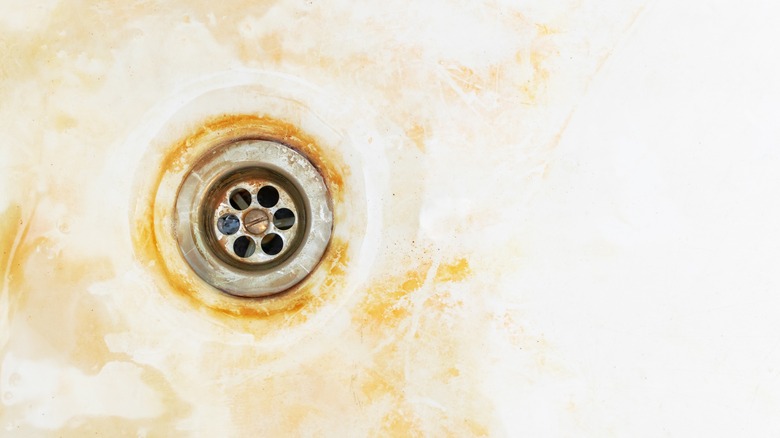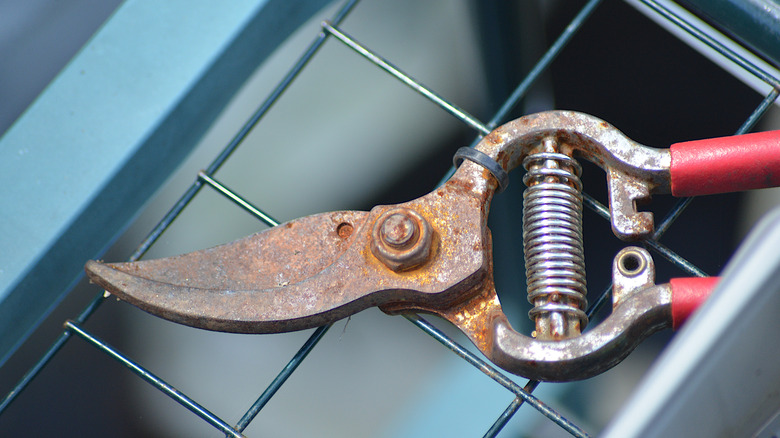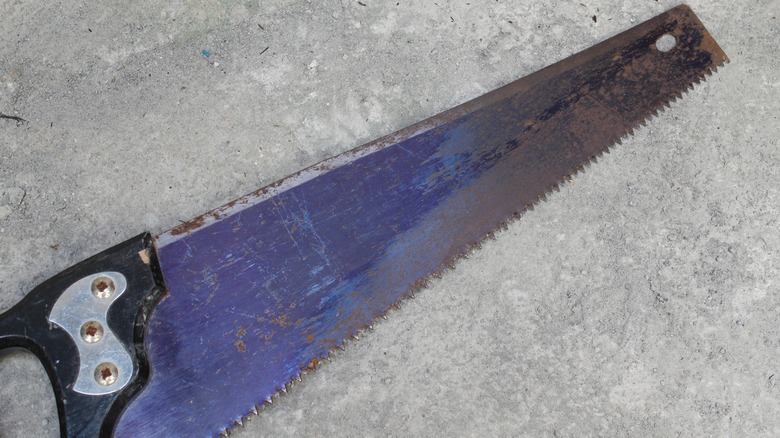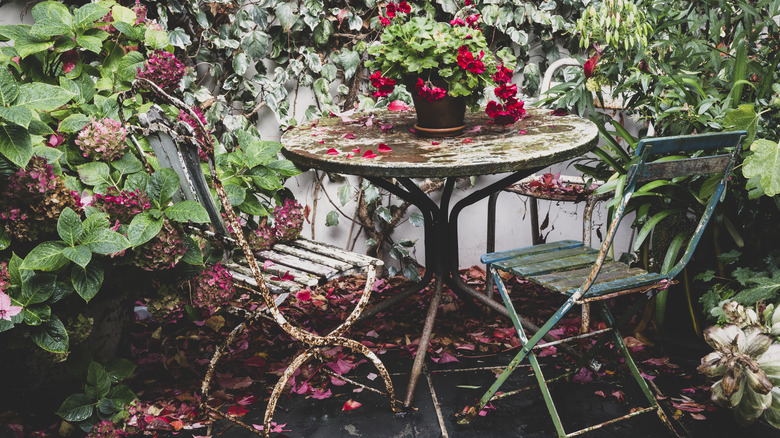8 Brilliant Hacks For Using Vinegar To Remove Rust Around Your Home & Garden
We may receive a commission on purchases made from links.
Are unsightly rust patches popping up to mar the surfaces of metal tools, furniture, and fixtures, both inside and outside your home? Iron oxide, aka rust, occurs when iron reacts with water or moisture along with oxygen in the air. If you ignore it, rust can eat away at metal until it weakens the structural integrity entirely. Fortunately, there's an inexpensive, readily available, tried-and-true solution for rust removal. It's vinegar. One of the most common kitchen ingredients for tackling rust stains, vinegar contains acetic acid. With a pH of 2.5, the acetic acid content in distilled white vinegar makes it a mild acid that is safe to use in a home setting but strong enough to dissolve rust. When acetic acid comes in contact with iron oxide, it initiates a process called neutralization.During this process, a molecular exchange occurs where the hydrogen within the acetic acid binds with the oxygen atoms in the oxidized rust, and the acetate ions bind with the iron ions to form iron acetate, a water-soluble salt. The result? No more rust, and, instead, a reddish-brown, muddy-looking residue that can be easily washed away.
Many metals contain enough iron to make them susceptible to rusting. Items made from mild steel, cast iron, wrought iron, chromed steel, and even stainless steel can all develop rust. You might find yourself trying to remove it from kitchen knives, garden tools, bathtubs, patio furniture, and more. Read on to discover techniques for putting vinegar to work removing the rust on these household objects. We've collected a list of eight cleaning suggestions along with explanations for why they work.
Revitalize your old cast iron pots and skillets by removing the rust with vinegar
Good cooks know how to care for the cast iron pans they use to turn out flavorful stews, steaks, and other delicious dishes. But when not in use, cast iron cookware can develop rust due to the presence of iron, oxygen, and moisture. If cast iron pots and skillets are not properly seasoned to protect their surfaces from moisture or if they are stored while they're damp, the result could be a rusty mess.
The first step in revitalizing a piece of rusty cast iron cookware is to fully submerge it in a sink or tub containing equal parts vinegar and water. The acetic acid in the vinegar will eat away the rust that coats the iron. Check the pot every 15 minutes and scrub off any loose rust with a stiff brush or steel wool. If the rust is not entirely removed, return the pot to the vinegar-and-water bath to continue soaking. It may take quite a bit of scrubbing at regular intervals for all of the rust to loosen. Don't allow the pot to soak in the solution any longer than necessary. Some sources say that 30 minutes is the maximum time you should soak it. This is due to the fact that once the acetic acid has eaten through the rust coating, it can start to slowly corrode the surface of the cast iron. After the layer of rust is loosened and scrubbed away, it's important to thoroughly rinse off the vinegar and season your cast iron pan with oil to prevent future rust formation.
Give rusty bolts, nuts, and hinges a vinegar bath to restore their shine
A lot of small items around the home are made of metals that contain iron (aka ferrous metals). Iron lends strength to things that need to do lots of heavy lifting for their size, such as hinges and fasteners. However, because ferrous metals are susceptible to the oxidation process between iron and moisture, nuts, bolts, and screws often become covered in rust. Fortunately, you can bring them back to life by giving them a bath in vinegar. The acetic acid will dissolve the iron oxide, transforming it to a salt that you can either rinse or scrub off.
Perhaps you have a collection of rusty bolts, nails, nuts, and hinges in your garage or workshop. Or, maybe a few small, metal home décor items are showing signs of rust. Instead of tossing them in the trash, you can soak them in straight, undiluted, distilled white vinegar. Start by washing the items to remove dirt and grease, exposing the rusted metal surface. Then, fully submerge the objects in the vinegar bath and leave them for 12 hours or overnight. Finally, remove the items from the vinegar and rinse them in a solution of water and baking soda before drying them thoroughly. The baking soda has a basic pH of 9, allowing it to neutralize the vinegar's acetic acid which has a pH of 2-3.
Use vinegar to banish the rust from chrome surfaces in your home
It's true that chrome does not actually rust. But many fixtures around your home as well as parts of your car are made of chrome-plated metal. When the chrome outer surface becomes worn or scratched, the underlying metal is exposed to air and moisture. If the metal contains iron, the result is rust formation. That's why you might notice brownish-orange stains on your faucets, shower heads, towel rods, and parts of the interior and exterior of your car. If you notice these marks popping up, you can eliminate the rust by cleaning the area with vinegar. The acetic acid in the vinegar will break down the build-up of iron oxide.
You can opt for straight vinegar, or try mixing lemon juice with distilled white vinegar to utilize the rust-dissolving power of both citric acid and acetic acid. The two acids remove the oxide ions from the iron to dissolve the rust, allowing it to lift off the surface. Use a clean cloth to apply the mixture to the rusty chrome. Let it sit for a few minutes before scrubbing the area with a brush. Alternatively, you could spray distilled white vinegar onto the rust spot and scrub it with a cloth. Finish the process by thoroughly rinsing and drying the chrome. It's important to limit the time that the vinegar stays in contact with chrome surfaces. Prolonged contact with acetic acid could dull their finishes.
Vinegar will dissolve the rust from your flatware and favorite kitchen knives
Knives, forks, spoons, and other metal kitchen utensils that contain iron are susceptible to rusting when not used frequently, especially in conditions where moisture and oxygen are present. In addition to looking dirty, rust on kitchen knives and utensils can introduce unsafe substances to your food. The USDA warns against using rusty utensils, but the main danger lies not so much in the rust itself, but in the bacteria its porous, irregular surface can house.
When you need to remove rust from your kitchen knives, grab a glass or jar and fill it with distilled white vinegar. Stand the knife in the glass so that the entire blade is submerged in the vinegar. After a 5-minute soak, use a sponge to scrub the rust from the knife blade. Rusty dining flatware and kitchen utensils can benefit from a vinegar bath. Fill a sink or tub with enough distilled white vinegar to submerge the items, and let them soak. It's not entirely clear how long one can safely leave cutlery in vinegar — some sources say to leave it overnight, and others recommend soaking items for under five minutes. We'd recommend erring on the side of caution with prized pieces like your favorite chef's knife. And speaking of caution, be aware that vinegar can cause a patina to form on carbon steel kitchen knives, so unless this is something you want, avoid using acetic acid on these blades.
After soaking, scrub away the rust with steel wool or a stiff brush. Finish the job by washing the items with soap and water to remove the vinegar. To prevent further rusting, dry the items thoroughly before storing them.
Use vinegar to tackle rust stains on bathtubs, toilets, and sinks
Many homeowners install white porcelain sinks and bathtubs in their kitchens and bathrooms. White porcelain looks pristine when it's sparkling clean and unblemished. But when orange rust stains appear, they really stand out against the white background of these surfaces. These rust stains are often caused by the chemical reaction of water and oxygen with iron from hard water. The iron could also come from rusty pipes or rusty parts in a water heater. Additionally, the porcelain coating in old sinks and bathtubs can wear down to the point that the underlying iron is exposed.
If you're tired of attacking these marks with your scrubbing arm, here's a passive approach to removing unsightly rust stains around your bathroom. For a porcelain sink or tub, simply fill it with warm water and add a generous amount of distilled white vinegar. Let the mixture sit overnight or for several hours. Then, drain the water, rinse, and wipe the porcelain surface with a cloth. For stains that are harder to access, you can spray vinegar onto the rust mark, or apply a vinegar poultice by soaking a cloth or paper napkin in vinegar and letting it sit on the stain for a few hours. This is also one of the methods for removing rust stains from different types of flooring, including concrete, marble, and porcelain tiles.
When you leave garden tools out in the rain, zap the rust with vinegar
We've all done it. After working in the garden, we conscientiously wipe down our tools and put them away, right? But what about that shovel or those pruning shears that you forgot to pick up from under a bush? The next time you see them, they'll be covered in rust from their exposure to the rain. The rainwater, along with oxygen in the air, will react with the iron in the metal tools to create rust. If it's left untreated, the rust will eat away at the metal, causing it to weaken until the tools are no longer useful.
For small implements like handheld clippers and trowels, the overnight vinegar bath is a go-to remedy for rust. Simply fill a bucket or tub with enough distilled white vinegar to submerge the small tools. As an alternative, you can wrap larger tools in vinegar-soaked rags to simulate the vinegar bath. After soaking the tools in undiluted white vinegar, scrub the loosened rust with a wire brush or steel wool. You can also follow up with a baking soda scrub. The abrasive texture will help to loosen any remaining rust. Additionally, the sodium bicarbonate in baking soda has a basic pH of almost 9 which will balance the acidity of the acetic acid in the vinegar (pH 2-3). Once the tools are de-rusted, clean, and dry, coat them well with a thin layer of vegetable oil, or a cooking spray from your pantry (like PAM) to prevent fresh rust from developing.
Don't discard those old, rusty tools in your garage or workshop when you can revive them with vinegar
Removing the rust on your metal tools with distilled white vinegar can bring those old saws, hammers, and screwdrivers back to life. Some sources suggest adding salt to the vinegar, with the logic being that mixing sodium chloride with acetic acid will form hydrochloric acid. This is a compound that is stronger than the acetic acid found in the vinegar alone. However, our research found that the scientific community is divided on whether the reaction really increases the acidity of vinegar. The efficacy of the amount of hydrochloric acid that might result from mixing salt and vinegar is unclear and may be too low to be of any material benefit.
Given the uncertain advantages of adding salt into the mix, we'd probably skip this step and rely on the rust-munching ability of straight vinegar, but feel free to try out the technique if you have some sodium to spare and want to experiment. To revive your rusty tools, start by cleaning them to remove dust and grime. Then, prepare a tub of distilled white vinegar that's deep enough to submerge the tools. Let the tools sit in the vinegar overnight. Wrap large tools in cloths saturated with vinegar and place them in sealed plastic bags. When you see that the rust has softened, remove the tools and scrub them with a wire brush or steel wool. Finish the project by rinsing the tools in a solution containing 2 tablespoons of baking soda for every 1 gallon of water, or do a baking soda scrub. The alkaline pH of the bicarbonate of soda will neutralize the acetic acid from the vinegar.
Reach for the vinegar to remove the rust from metal patio furniture
When you were busy buying the perfect outdoor furniture for your patio and garden, you might have opted for metal chairs, benches, and tables. Although built for durability, furniture that is made of wrought iron or any metal alloy containing iron will develop rust over time, especially in humid or coastal areas.
The acetic acid in vinegar can dissolve the rust on metal patio furniture. However, furniture is too large and unwieldy for a vinegar bath. One method is to apply the vinegar from a spray bottle. Spray the liquid onto the rusted areas of the patio furniture and let it sit for 30 minutes to a few hours. When you see that the rust is loosening, scrub the area with a wire brush or steel wool. Repeat the procedure as needed to remove all of the rust. When your piece of patio furniture is rust-free, rinse it with a solution of 1 cup baking soda dissolved in 1 gallon of water to neutralize the acetic acid in the vinegar. Finish the project by drying the furniture with towels. You might also want to consider painting your outdoor furniture, starting with a coat of steel primer, such as the Rust-Oleum Rusty Metal Primer, which costs $16.48 on Amazon.
